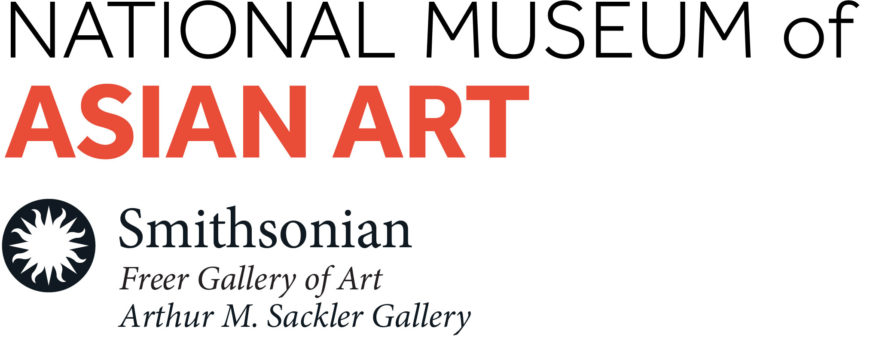Lidded ritual ewer (guang) with taotie, dragons, birds, tigers, elephants, fish, snakes, and humans, Shang Dynasty, Middle Yangzi Valley, China, c. 1100–1050 B.C.E., bronze, 31.4 x 31.5 x 14.4 cm (Freer Gallery of Art, Smithsonian Institution, Washington DC; Gift of Eugene and Agnes E. Meyer, F1961.33a-b)A conversation with Keith Wilson, Curator of Ancient Chinese art, and Beth Harris
[0:00] [music]
Dr. Beth Harris: [0:04] We’re looking at an amazing ancient Chinese bronze vessel, one that’s about 3,000 years old.
Keith Wilson: [0:12] Objects like this were made to be used in elaborate ritual banquets offered to deceased ancestors. For a pitcher or ewer like this, it’s thought that its particular function would have been containing warm liquids. That’s why it’s got a lid, probably wine made from brewed grains, the ancestral version of sake that we know today.
Dr. Harris: [0:35] Ancestor worship is such an important part of Chinese culture. This is during the Shang Dynasty, when this practice emerges.
Keith: [0:43] Ancestor worship has a very long history in China. We can be very confident about its existence during the Shang Dynasty because bronze containers that were used in ritual ceremonies often bear inscriptions. The inscriptions name deceased ancestors — “My deceased father, Ding. My deceased mother, Wu.” So we know that these objects had close associations with deceased family members.
Dr. Harris: [1:09] And they were often found in tombs.
Keith: [1:11] Vessels like this were made for use during life. They’re often taken to the grave because they were treasured objects. There was a sense that ancestor worship had to continue in the afterlife.
Dr. Harris: [1:23] It’s important for us to talk about how difficult it was to make these objects.
Keith: [1:29] The advent of the use of bronze signifies an important turn in human history. Bronze is a man-made medium. It illustrates very clearly the advent of the human ability to manufacture materials that don’t occur in nature.
[1:45] For bronze, the constituents do appear in nature. It’s copper, tin, and lead. We’re looking at the final stage of a very long process that needs to be traced all the way back to the extraction of the raw ores from the earth. Those ores would have been refined and possibly shipped a long distance from their source of extraction to where they would have been used in foundries.
Dr. Harris: [2:10] Bronze ages in a particular way. And so we’re looking at a surface that is very different than when it emerged from its mold.
Keith: [2:19] We should think of the original surface as like copper, [a] new penny. As an object like this is buried for prolonged periods of time in the moist environment of a subterranean tomb, what happens is what we call a patina, a kind of corrosion, forms on the surface.
Dr. Harris: [2:36] As I look at this, it feels as though it’s teeming with life.
Keith: [2:40] When I first saw this, I was amazed at the vitality of the surface. There are all sorts of animals that are recognizable, but not all are complete. In some cases, only heads.
Dr. Harris: [2:52] For example, at the very front of the lid, we see what looks to me like a monster face with horns.
Keith: [2:59] But there’s no body. A similarly dismembered element appears at the back of the lid, where you’ve got a head that looks like the head of a buffalo. And again, a search for a body comes up fruitless.
Dr. Harris: [3:10] And we don’t always have real animals. We have imaginary, composite creatures.
Keith: [3:14] If we look at the buffalo, he’s given a pair of very strange horns that are in the form of fish. Not only are these not all real animals, but many of them are quite fantastical.
Dr. Harris: [3:25] In between the recognizable animals — dragons, and elephants, and tigers — are these spiral forms that also feel so alive.
Keith: [3:36] The tiger looks like he’s about to pounce. He’s looking over his shoulder, so you get a sense that the artisan knew the animal that he was drawing.
[3:44] My favorite is the standing bird. From a distance, it seems to be represented almost whole. You have him looking straight forward with staring eyes, his beak leaps off the front of the vessel.
[3:57] He’s got wings along the flanks of the vessel. Its legs are the front pair of legs of the container itself. But when you start looking closer, components of that bird are quite fantastical themselves. The wing takes the shape of a coiled dragon.
[4:13] I wish I knew what a person who was using this vessel 3,000 years ago would’ve thought when looking at these motifs. When I look at them, a depiction of a world that is in constant flux, where things are emerging and retreating, coming into shape and disappearing, going back and forth between a natural world and a supernatural world.
Dr. Harris: [4:39] Also, there are times when we see one animal in the jaws of another.
Keith: [4:43] One characteristic of Chinese bronzes of this period is a kind of brutality. There’s a large monster mask with its jaws wide open. What’s inside its jaws but the head of a humanoid who is essentially the back leg of the vessel? Then he seems to be encased in a serpent that surrounds his body.
Dr. Harris: [5:05] There were many cities that were producing bronze vessels, most of them for ritual use.
Keith: [5:10] At the advent of the Bronze Age, access to man-made metal like bronze would’ve been most important for practical reasons — agricultural tools and weapons, for example.
[5:21] What’s completely interesting about the Chinese instance is that the resource that could have been used solely for practical reasons of increasing agricultural output or conquering enemies was chiefly reserved for use to create incredibly important ritual objects like containers used in ancestor worship.
Dr. Harris: [5:43] But that makes sense in that worldview if the sacrificing to the ancestors could ensure harvests, could ensure the wellbeing of the state and its people.
Keith: [5:54] The fact that bronze was reserved for these very special functions indicates that these containers were among the most important objects that were being made at the time. It’s thought that given the complexity of the ancient bronze industry [it] was probably the special prerogative of the king.
Dr. Harris: [6:13] It looks as though it was cast, it was created in one piece.
Keith: [6:17] The lid would have been made separately. The handle was made as a third piece. Each of those units would have been made in a separate piece-mold assembly. This object started as a ceramic model, and the decoration may well have been carved in the ceramic body of the model.
[6:36] It’s this technical difference that allows us to think of the Chinese Bronze Age as an independent, local invention that was created by Chinese craftsmen.
[6:46] [music]
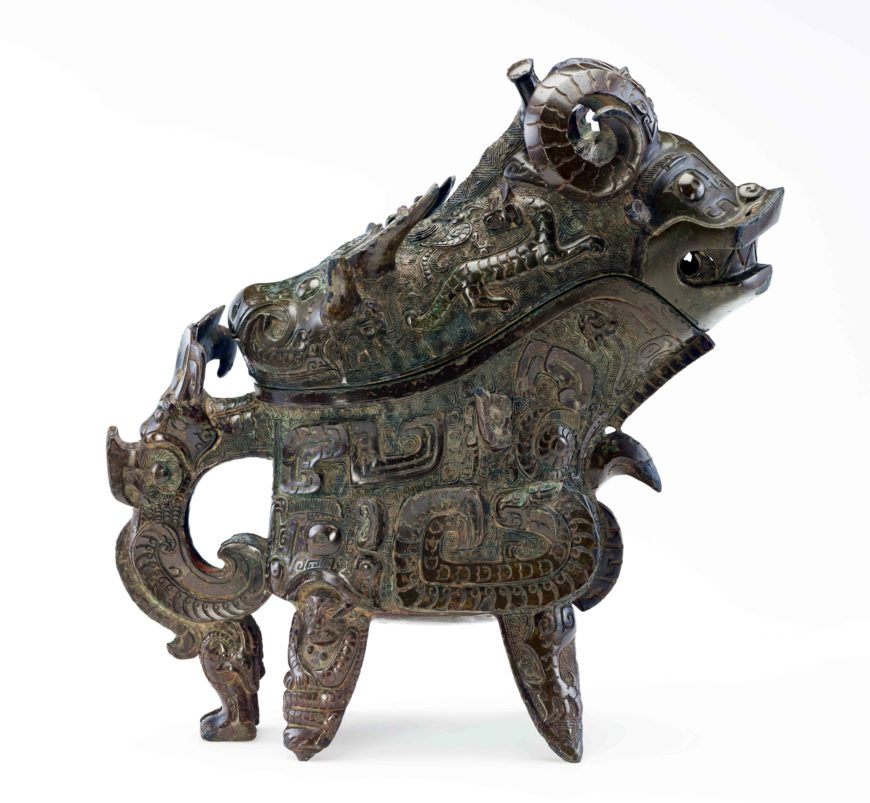
Lidded ritual ewer (guang) with taotie, dragons, birds, tigers, elephants, fish, snakes, and humans, c. 1100–1050 B.C.E., bronze, China, Middle Yangzi Valley, 31.4 high x 31.5 x 14.4 cm (Freer Gallery of Art, Smithsonian Institution, Washington, DC: Gift of Eugene and Agnes E. Meyer, F1961.33a-b)
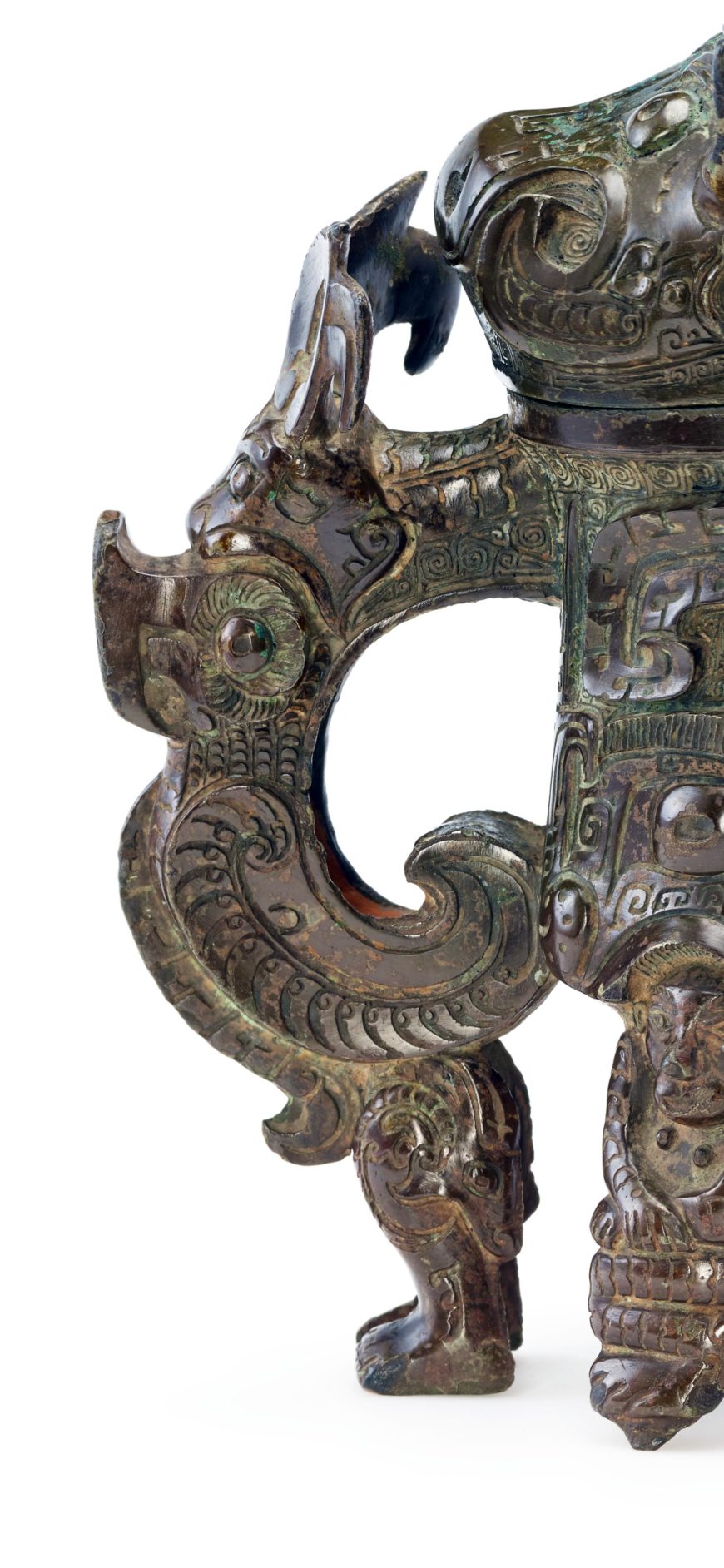
Handle of lidded ritual ewer (guang) with taotie, dragons, birds, tigers, elephants, fish, snakes, and humans, c. 1100–1050 B.C.E.
This interestingly shaped ewer, a vase-shaped pitcher, is called a guang (“gwang”) in Chinese. It is designed as a pouring vessel. The broad, raised spout aligns with a vertical handle at the back. It ingeniously combines a handful of fantastic beasts into its form. At the front of the vessel is a horned bird with a hooked beak. Its wings, composed of coiled dragons, cover its flanks. The space between these areas is filled with matching pairs of dragons, reptiles, and birds.
The handle also takes the shape of a standing bird, its head caught in the jaws of a horned beast. It divides the animal mask—taotie—into halves. Find one of its staring eyes. Below it is a snout and open mouth. The creature has the head of a snake man in either side of its mouth. The lid is decorated with two prominent animal masks: a ram head at the front and a buffalo head at the back. See if you can identify the animals that form their horns and fill the area between the two bodiless heads.
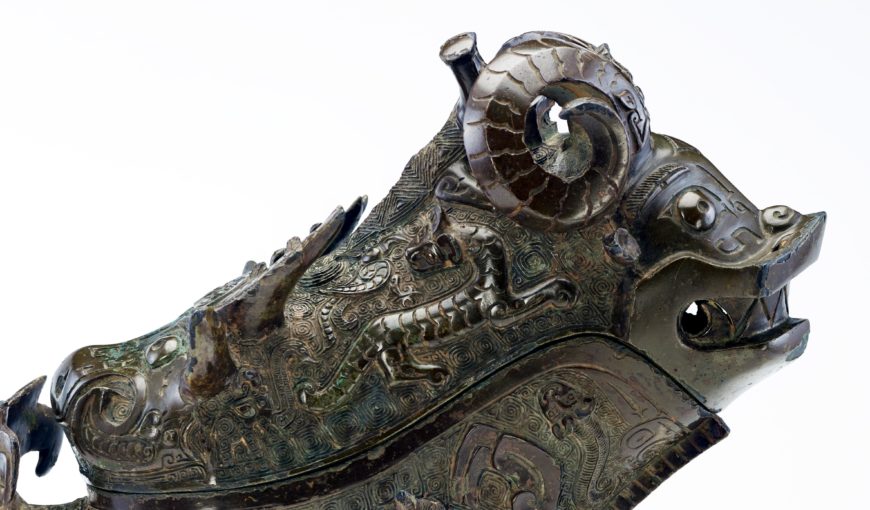
The lid of a ritual ewer (guang) with taotie, dragons, birds, tigers, elephants, fish, snakes, and humans, c. 1100–1050 B.C.E., bronze, China, Middle Yangzi Valley, 31.4 high x 31.5 x 14.4 cm (Freer Gallery of Art, Smithsonian Institution, Washington, DC: Gift of Eugene and Agnes E. Meyer, F1961.33a-b)
Real and imaginary animals are frequently seen in the surface decoration of ancient Chinese bronzes. Realistic depictions of living animals were typically produced in southern China, while in the north, fantastic creatures were prevalent. One of the most characteristic mythical images decorating Shang vessels is the so-called taotie. It is a frontal animal-like mask with a pair of staring eyes, often protruding in high relief. Between the eyes is a nose, with jaws shown directly below. The taotie motif here also includes eyebrows, horns, ears, snout, and fangs. The emergence of animal-shaped bronze vessels and the popularity of animal motifs clearly indicate the importance of animals in the repertoire of artisans of this era.
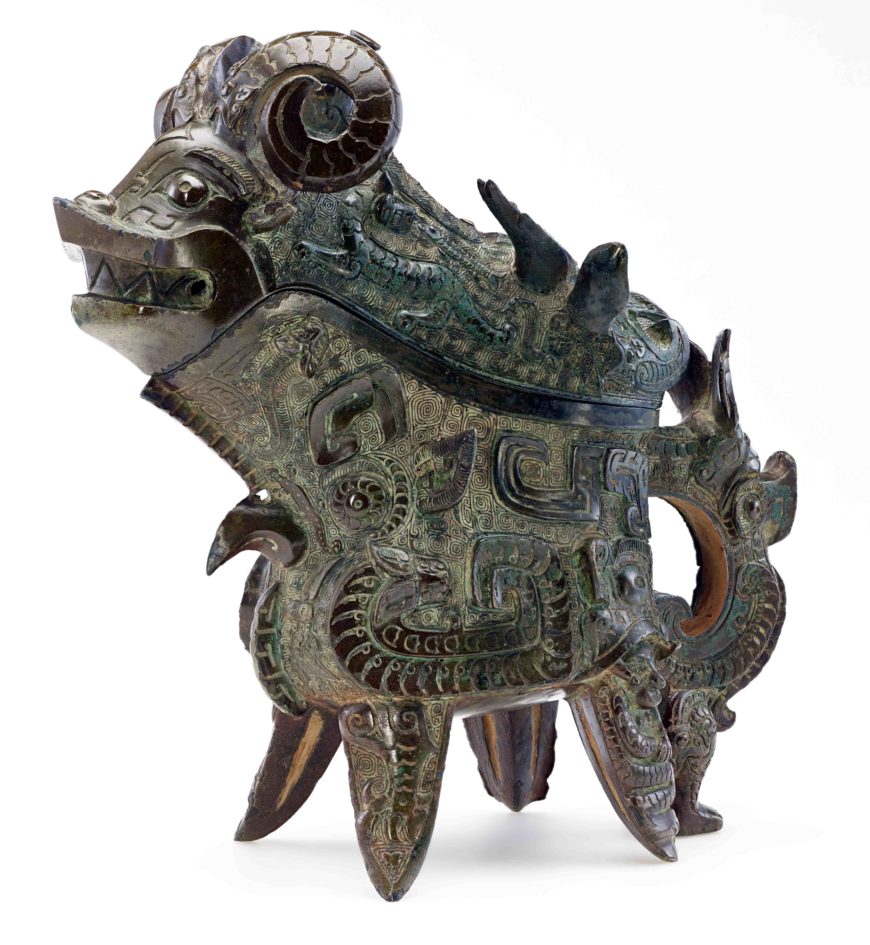
Lidded ritual ewer (guang) with taotie, dragons, birds, tigers, elephants, fish, snakes, and humans, c. 1100–1050 B.C.E., bronze, China, Middle Yangzi Valley, 31.4 high x 31.5 x 14.4 cm (Freer Gallery of Art, Smithsonian Institution, Washington, DC: Gift of Eugene and Agnes E. Meyer, F1961.33a-b)
Chinese bronzes like this guang show a mastery in casting rivaling that of other ancient civilizations. They were used to hold wine, water, grain, or meat in sacrifices to ancestors or in ritual banquets by Shang kings. The shape of each vessel matches its intended purpose. The fabulous animal motifs are unlikely to have been purely decorative. Although their exact meanings are unknown, they must have played a certain role in the rituals or in the popular imagination.
This resource was developed for Teaching China with the Smithsonian, made possible by the generous support of the Freeman Foundation

